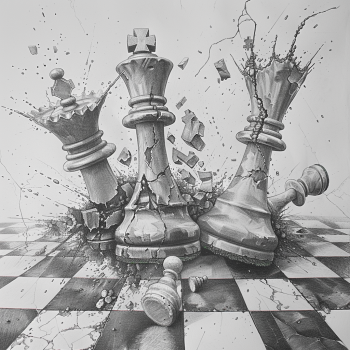Hello, I am Tushar. Today, the blog’s topic is a little different. I will not discuss tactical themes, nor will I show any deep positional game; instead, I will present some simple strategic ideas to help you understand what to do when you don’t have much in the position. I’ll be using the term “small improvement”.
I will be talking more theoretically than showing you practical examples, so please read carefully.
Should we go for checkmate instantly?
The aim of a chess game is to checkmate your opponent. But does playing for a mate from the start of a game make much sense? That only works against beginners. One intermediate goal is to win material. If you have more material, it is easier to deliver mate. But winning material is not easy to achieve either.
We need a more modest intermediate goal. We must try to keep improving our position, which can be done in many ways. For a while, these improvements can be tiny and scarcely perceptible. You cannot count them like you do when gaining material.
Activity
You must place your pieces well. That means that a piece must be doing ‘something’ useful. It must be active. In chess, activity means that a piece:
- is mobile (able to make several moves)
- is attacking (opposing pieces or squares)
- is restricting the activity of opposing pieces
- is cooperating with other pieces
As far as cooperation is concerned, we will make sure to repeat what we discussed in previous blogs. Various forms of cooperation are possible:
- one piece supports another piece in an attack (the twofold attack)
- one piece protects another which is under attack
- pieces complement each other in the control of squares
- pieces share the task to be done (chaser or guard)
- pieces do not get in each other’s way
The role of the pawns
Two pawns standing next to each other are often strong because they control four squares on the rank in front of them. Both white and black squares. As soon as one of these pawns advances, this ideal cooperation disappears. However, the front pawn is then protected.
Pawns one behind the other are usually weak. Doubled pawns also control four squares, but these must be neatly combined. Doubled pawns cannot protect each other. The rook pawn is the weakest. It only threatens one square.
Motive (Tactical weaknesses)
What does motive mean? Whatever is an advantage for one side is a disadvantage for the other. Supposing White attacks an unprotected piece: target ‘material’. For Black, the unprotected piece is a “motive” and sets off a defensive operation.
What else can be a motive?
- the king
- unprotected or insufficiently protected pieces
- high-value pieces
- pieces on the same file, rank or diagonal
- an important defender
- a piece with restricted mobility
- opponent has a far-advanced pawn
In the diagram, we can see two important defenders. For Black, the knight is protecting the important d8-square. The knight is also in danger. The white rook may not leave the back rank in view of the mate. So, Black is in luck. He can play Nc6-d4.
Roughly speaking, a small improvement can be no more than:
- increasing your own activity
- lessening your own vulnerability
- restricting your opponent’s activity or even making it harmless to you
- increasing your opponent’s vulnerability
Turning this into operations on the board:
- improving your pawn structure (e.g. creating a pawn duo or undoubling pawns)
- improving the setup of your pieces (e.g. activating them)
- damaging your opponent’s pawn structure (giving him doubled pawns)
- worsening the setup of opposing pieces (limiting their mobility or even cutting them off)
- destroying your opponent’s attacking chances (exchanging his strongest attacking piece)
- sharing out the tasks to be done by your own pieces as well as possible (this piece can protect better, that one is a better attacking piece, and above all, being sure they are not getting in each other’s way)
We shall now start with the pawn structure.
Pawn structure
Please take a look at the diagram below.
There is a big difference between the white and black pawn structure. Black has a sound pawn structure. He has only two pawn islands. The h7-pawn is his weakest one because for the moment it cannot move.
As a whole, the white pawns are not linked. They are isolated. That is what we call such pawns. The c-pawn is an isolated pawn. Other pawns cannot protect them.
White will have to come up with a good plan, whereas, on the other hand the black knight can go hunting for booty.
White has a good plan to change the structure.
Now It’s time for you to do some work. I will present ten examples as a test. Once you solve the puzzle, you will see my comments on each move.
Exercise 1
Exercise 2
Exercise 3
Exercise 4
Exercise 5
Exercise 6
Exercise 7
Exercise 8
Exercise 9
Exercise 10
Summing up
In chess, you have to play sound moves. You must try to improve your position and – as we have seen in these examples and test examples – there are many different ways to do that. Strong points and weaknesses are the hint.
- increasing our own activity
- lessening our own vulnerability
- limiting or even eliminating the activity of our opponent
- increasing our opponent’s vulnerability
The first and the fourth point were dealt with in detail:
improving the positioning of the pieces (e.g. activating them)
damaging our opponent’s pawn structure (giving him doubled pawns)
You can try to make use of small improvements in your own games. In the meantime, practice with the chess.com bots here. https://www.chess.com/play/computer
Good luck!




